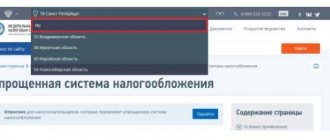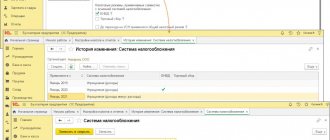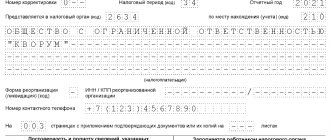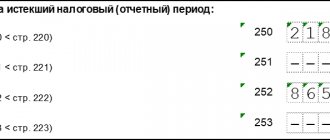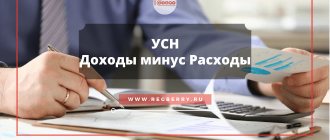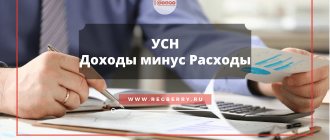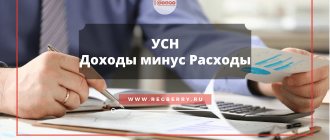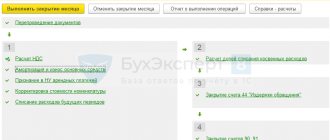What to do with “old” objects
In this case, first of all, you should determine the residual value of the object (paid!) at the time of transition to the simplified tax system. If the company applied the general tax regime, do this according to the rules of Chapter 25 of the Tax Code of the Russian Federation, and if imputed, use accounting data. When switching from the “income” simplified tax system to the “income-expenditure” system, the residual value of the fixed assets is not determined. This rule also applies to those who previously used the patent tax system. That is, these persons will not be able to take into account the residual value of “transitioned” objects in “simplified” expenses (clause 2.1 of Article 346.25 of the Tax Code of the Russian Federation, letters of the Federal Tax Service dated September 3, 2015 No. GD-4-3/15507 and the Ministry of Finance of Russia dated February 19, 2009 No. 03-11-06/3/35).
What if fixed assets were purchased using the OSN, then the simplified tax system and after some time changed the object to “income minus expenses”? In this case, at the time of the last transition, the residual value of these fixed assets is also not determined. This is exactly what financiers think (letters dated November 20, 2018 No. 03-11-11/83506, dated April 14, 2011 No. 03-11-11/93 and dated April 11, 2011 No. 03-11-06/2/51). As for the tax authorities, not so long ago they supported their colleagues [email protected]
When switching to the “simplified” system, businessmen need to follow the same rules as companies. This follows from paragraph 4 of Article 346.25 of the Tax Code of the Russian Federation. For example, an individual entrepreneur - a former impostor - determines the residual value of fixed assets, focusing on the norms of PBU 6/01 (see letters from the financial department dated October 21, 2010 No. 03-11-11/279 and dated February 13, 2013 No. 03-11-11/67) .
Subparagraph 3 of paragraph 3 of Article 346.16 of the main tax document provides for a special procedure for writing off the residual value of “old” fixed assets. It all depends on the useful life of the object:
- SPI up to three years inclusive - during the first calendar year of application of the simplified system;
- SPI over three and up to 15 years inclusive - 50% of the cost in the first simplified taxation system year, 30% and 20% in the second and third years, respectively;
- SPI over 15 years - during the first 10 years of application of this special regime.
The useful life is determined according to the Classification of fixed assets included in depreciation groups, approved by Decree of the Government of the Russian Federation dated January 1, 2002 No. 1. If some fixed assets are not included in this regulatory act, SPI for them should be established in accordance with technical conditions or recommendations of organizations -manufacturers.
To receive a more detailed answer on the issue of classification of fixed assets included in depreciation groups, financiers advise contacting the Ministry of Economic Development (letter dated June 25, 2018 No. 03-03-07/43521).
For tax purposes, accept the residual value of the asset quarterly in equal shares (see letters of the Ministry of Finance dated January 17, 2008 No. 03-04-06-01/6, dated September 25, 2007 No. 03-11-04/2/234). And one more thing - show information on the “old” OS in column 8 of Section II of the Book of Accounting for Income and Expenses (hereinafter referred to as the Book).
Current
Before switching to the simplified system, do not forget to restore the VAT previously accepted for deduction on fixed assets. “Reanimate” the amount of tax proportional to the residual (book) value of the object without taking into account revaluation, and include it in the “profitable” expenses of the year preceding the transition to the simplified tax system (clause 3 of Article 170 of the Code, letter of the Ministry of Finance dated January 12, 2017 No. 03-07 -11/536 and dated January 27, 2010 No. 03-07-14/03). Reflect the restored tax in the sales book, as well as in the VAT return for the fourth quarter on line 080 of section 3.
At what cost to keep fixed assets for the simplified tax system “income minus expenses”
The procedure for determining the value in accounting for fixed assets under the simplified tax system depends on when the fixed assets were acquired and put into operation:
- If this happened after the transition to the simplified system, then fixed assets that were acquired/created during the period of being on the simplified tax system are accepted for accounting at their original cost, determined in the manner established by the legislation on accounting (clause 3 of article 346.16 of the Tax Code of the Russian Federation, clause 3.10 The procedure for filling out KUDIR, approved by order of the Ministry of Finance of Russia dated October 22, 2012 No. 135n).
If you have access to K+, check whether you have correctly determined the initial cost of fixed assets. If you don’t have access to K+, get a free trial access and go to the Guide to the simplified tax system.
2. If this happened before the transition to the simplified tax system with the object “income minus expenses” (clause 3 of article 346.16, clause 2.1 of article 346.25 of the Tax Code of the Russian Federation), the determination of the cost depends on what mode the transition was from:
- with OSNO - at the residual value in the form of the difference between the acquisition price and the amount of depreciation accrued according to the “profitable” rules in accordance with Chapter. 25 Tax Code of the Russian Federation;
- Unified agricultural tax - at the residual value, determined by the residual value of fixed assets on the date of transition to payment of unified agricultural tax, reduced by the amount of expenses taken into account during the period of application of the agricultural regime;
- when switching from the simplified tax system to “income”, the residual value is not determined.
To learn about the costs of fixed assets for which purposes can be taken into account for the simplified tax system, read the material “For the simplified tax system, expenses only for “production” fixed assets are taken into account .
Residual value: a few nuances
Keep in mind that the mentioned algorithm must be adhered to, even if there is nothing to the end of the object’s SPI. Let’s say an organization switching to “simplified” has a passenger car. According to Decree of the Government of the Russian Federation dated January 1, 2002 No. 1, it belongs to the third depreciation group (SPI over 3 years to 5 years inclusive). The company has set a 4-year service life for this machine. When the company decided to say goodbye to the general tax regime, there were only a few months left until the end of the car’s STI. That is, with OSN this car would have been depreciated very soon. But under the special regime, its residual value, whether you like it or not, will have to be included in expenses for three years (50% in the first year, 30% and 20% in the second and third, respectively).
In accounting, the company will depreciate the object in the same manner until the end of its SPI.
note
According to the auditors, if an organization did not pay for the property received during privatization, then it has no reason to take into account the residual value of this fixed asset in expenses when applying the simplified tax system (letter of the Federal Tax Service of Russia dated 02/08/2011 No. KE-4-3/1930). However, the arbitrators do not agree with this approach, pointing out that the “simplified” has the right to accept the residual value of such fixed assets in any case (see the resolutions of the AS of the Far Eastern District dated December 15, 2015 No. F03-5278/2015 and the Federal Antimonopoly Service of the East Siberian District dated November 13, 2008 in case No. A33-919/08, upheld by the rulings of the Supreme Court of the Russian Federation dated April 12, 2016 No. 303-KG16-2255 and the Supreme Arbitration Court of the Russian Federation dated March 23, 2009 No. VAS-187/09).
Does the simplifier have the right to take into account in the costs the residual value of objects received as a contribution to the authorized capital during the period of application of the OSN? No, financiers say. After all, the organization does not bear the costs of purchasing such OS (letter dated 02/08/2013 No. 03-11-06/2/3022). It will be extremely difficult to argue with officials - the servants of Themis are in solidarity with them (see, for example, resolutions of the Federal Antimonopoly Service of the North-Western District dated 05.26.2008 No. A56-25050/2006 and dated 09.28.2007 No. A56-4532/2007, as well as the Ural District dated December 15, 2008 No. Ф09-9338/08-С3).
Organizations acquiring fixed assets often use the so-called depreciation bonus. That is, they immediately include in tax expenses 10 percent (30% for objects from the 3rd to 7th amogroups) of the initial cost of the fixed assets (clause 9 of Article 258 of the Tax Code of the Russian Federation). How to determine the residual value of such property when switching to “simplified”? The answer is in the letter of the financial department dated September 13, 2006 No. 03-11-04/2/192. This will be the difference between the original cost of the asset, reduced by the above premium, and the amount of accrued depreciation.
The use of bonus depreciation is the right, not the obligation of the company. Establish in the accounting policy the procedure for its “operation” and the size, as well as the criteria according to which this bonus is applied to all or individual objects (letters of the Ministry of Finance dated 04/21/2015 No. 03-03-06/1/22577, dated 11/17/2006 No. 03 -03-04/1/779). But keep in mind that amopremium is not calculated in accounting. This means that when it is applied, tax and accounting depreciation will not coincide, which will lead to differences according to PBU 18/02.
note
If a “physicist” purchased an operating system before state registration as an individual entrepreneur, the costs of its purchase should not be taken into account when applying the simplified tax system. The financiers emphasized this in letters dated 02/26/2013 No. 03-11-11/82, dated 08/15/2017 No. 03-11-11/52240. And just recently, the Ministry of Finance again had the right to accept the costs of purchasing an apartment for the purpose of its further resale, but only if he incurred them after registering as an individual entrepreneur (letter dated August 13, 2019 No. 03-11-11/60923).
If the equipment purchased by the simplified person meets the definition of depreciable property, then the costs of its acquisition are taken into account when calculating the base for the single tax. At the same time, costs in the form of the redemption value of the land plot are not included in the costs of fixed assets. It will be possible to accept the costs of an allotment only when it is purchased for the purpose of further resale (see letters of the Federal Tax Service of the Russian Federation for Moscow dated November 17, 2010 No. 16-15/120859, Ministry of Finance of Russia dated June 30, 2011 No. 03-11-06/2/ 101, dated 04/08/2011 No. 03-11-06/2/46, dated 03/29/2019 No. 03-11-11/21804).
OS “born” under the simplified tax system
Expenses for fixed assets acquired during the “simplification” can be accepted from the moment these objects are put into operation. But it will be possible to take into account such costs only for paid assets and used in business activities. And if the rights to OS are subject to state registration (this is relevant, for example, for real estate), it will be possible to reflect the costs of its purchase only from the moment of documented submission of papers for registration (Article 346.16 of the Tax Code of the Russian Federation, letter of the financial department dated November 18, 2013 No. 03- 11-06/2/49385, Resolution of the Federal Antimonopoly Service of the North-Western District dated 02.09.2010 No. A42-4274/2009).
Fiscal officials emphasize that expenses for the acquisition of fixed assets are accepted in the period when one of the events occurred most recently: payment (including partial) of the object or commissioning or start of use in “profitable” activities. If the “simplifier” purchased and launched an asset, but it was not involved in business, there is no reason to account for expenses for its purchase (letter of the Federal Tax Service of Russia dated March 31, 2011 No. KE-3-3/1003).
A practical situation. An organization using the simplified tax system bought a building, registered the rights to it and put it on its balance sheet, after which a decision was made to demolish this structure to prepare a site for the construction of a residential building. The acquired facility was not put into operation. And this is one of the indispensable conditions for recognizing the costs of purchasing an OS under the “simplified” system, financiers noted. Therefore, the company will lose these expenses (letter dated July 22, 2008 No. 03-11-04/2/110).
And further. Let’s assume that expenses for the purchase of fixed assets were incurred in 2018, during the period of application of the “profitable” simplified tax system. And this asset was put into operation already in 2022, when the “simplified” object changed to “income minus expenses.” In such a situation, these costs can be accepted in 2022 - officials are not against it (see letters from the Ministry of Finance dated 08/17/2018 No. 03-11-11/58541, dated 02/25/2013 No. 03-11-11/81 and dated 12/15/2011 No. 03-11-06/2/170).
The cost of a fixed asset is determined according to the same rules as in accounting, and is written off during the calendar year in equal shares on the last day of each quarter. There is no need to accrue depreciation (clause 3 of article 346.16 of the Tax Code of the Russian Federation, clause 3.10 of the Procedure for filling out the Book, approved by Order of the Ministry of Finance of Russia dated October 22, 2012 No. 135n, letter of the Federal Tax Service dated January 9, 2018 No. SD-4-3/6 and the financial department dated September 14, 2016 No. 03-11-11/53647).
“Simplers” are not recognized as payers of value added tax. Therefore, they include VAT amounts in the initial cost of the fixed assets and charge them to expenses as part of it. This is exactly what financiers recommend to do (see letters dated November 12, 2008 No. 03-11-04/2/167 and letters dated October 4, 2005 No. 03-11-04/2/94). The arbitrators also agree with them (Resolution of the Arbitration Court of the Volga-Vyatka District dated June 19, 2015 No. F01-951/2015, upheld by the Ruling of the Armed Forces of the Russian Federation dated October 15, 2015 No. 301-KG15-12232). That is, VAT is not taken into account separately in expenses in this case. The amount of VAT paid to the budget by the tax agent should also be included in the initial cost of the purchased object (letter of the Ministry of Finance of Russia dated June 30, 2011 No. 03-11-06/2/101).
note
The specified procedure for writing off expenses for acquired fixed assets does not depend on their useful life (unlike the situation with “old” assets).
Example 1. Accounting for fixed assets purchased under the simplified tax system
An organization using the “income-expenditure” simplified tax system acquired a fixed asset worth 500,000 rubles in June. (including VAT) and paid it in the same month. The asset was put into operation in August of the same year and immediately began to be used in production. State registration of property is not required. Thus, all conditions for accepting the costs of this asset were met in August. The company's accountant reflected in the simplified tax system expenses the initial cost of this fixed asset on September 30 and December 31 in equal shares, that is, 250,000 rubles each. (500,000 rubles / 2 quarters) for each of these dates. If the company fulfills all the conditions for accounting for expenses for the acquired object, for example, in November, then the accountant will write off the costs on December 31 in a lump sum in the amount of 500,000 rubles.
By the way, nothing prevents the “simplified” person from taking into account the costs of acquiring objects that are leased and meet the requirements of clause 1 of Art. 256 Tax Code of the Russian Federation. The same applies to the investor’s costs for the purchase of non-residential premises built under an investment agreement (see letters from the Ministry of Finance of Russia dated December 2, 2010 No. 03-11-06/2/181 and dated November 28, 2011 No. 03-11-06 /2/162).
Let us note that the ability to take into account the costs of fixed assets does not depend on what funds - borrowed or own - the simplifier made these expenses with. Financial department specialists drew attention to this in letters dated 08/06/2019 No. 03-11-11/59075 and dated 08/28/2018 No. 03-11-06/2/61172.
Accounting for fixed assets under the simplified tax system “income”
“Simplers” who have chosen the object of taxation “income” do not take into account any expenses for tax purposes (clause 1 of Article 346.18 of the Tax Code of the Russian Federation), therefore they cannot in any way reduce the tax due to expenses associated with the acquisition of fixed assets.
However, this does not mean that OS objects can be ignored. You will still have to keep records of fixed assets under the simplified tax system “income”. The fact is that the residual value of fixed assets is important as a criterion that allows you to switch to the simplified tax system and apply this particular special regime. All “simplified people” (as well as those who are just planning to switch to the simplified tax system) must comply with it equally, regardless of the chosen object of taxation. The Russian Ministry of Finance drew attention to this in its letter dated September 18, 2008 No. 03-11-04/2/140.
Let us recall that the threshold for the residual value of fixed assets, above which the application of the simplification is impossible, is established in subparagraph. 16 clause 3 art. 346.12 Tax Code of the Russian Federation. From 2022 it will be 150 million rubles. The residual value indicator is calculated according to accounting data.
NOTE! This limitation on the residual value of fixed assets applies to both organizations and individual entrepreneurs (see, for example, letter of the Ministry of Finance dated November 2, 2018 No. 03-11-11/78908).
When selling fixed assets, “profitable” “simplified” accounts for the corresponding proceeds in the generally established manner.
More details about this can be found in the material “ Procedure for selling OS under the simplified tax system “income” ” .
IMPORTANT!!! From 01/01/2022, the use of FSBU 6/2020 “Fixed Assets” is mandatory for all organizations. Organizations that have the right to conduct simplified accounting (and these often include simplified ones) are exempt from the application of certain points of the new standard. It is necessary to determine the residual (book) value to control the limit on the value of fixed assets based on accounting data, that is, on the basis of FSBU 6/2020.
What to keep in mind when paying in installments
Fixed assets cost a lot. Therefore, “simplistic” people sometimes buy them in installments. In such a situation, expenses for the commissioned operating system are accepted in the reporting (tax) period evenly in the amount of amounts actually paid (letters of the Ministry of Finance of Russia dated May 17, 2011 No. 03-11-06/2/78, dated December 13, 2010 No. 03-11- 11/287).
What if the property was purchased in installments by a “profitable simplifier”, who after some time changed the object to “income minus expenses”? Then he has the right to take into account the cost of such an asset in the part paid after changing the object of taxation (letter of the Ministry of Finance of Russia dated December 9, 2013 No. 03-11-06/2/53560).
Often you have to pay interest to pay in installments for the cost of property. How to take them into account when using the simplified tax system? The answer is in the latest letter from the financial department dated July 26, 2019 No. 03-11-11/55825. In it, officials referred to paragraph 1 of Article 823 of the Civil Code of the Russian Federation, from which it follows that installment payment for goods is a type of loan. This means that the “simplified” person has the right to attribute the mentioned interest to expenses under sub-clause. 9 clause 1 art. 346.16 of the main tax document, which allows you to take into account, among other things, interest on the loan. It is important that such costs are accepted in the manner prescribed by Article 269 of the Code.
Let us note that the position of financiers has changed. Previously, they believed that interest on installments must be taken into account as part of expenses for the purchase of fixed assets according to the instructions established by clause 3 of Art. 346.16 of the Tax Code of the Russian Federation, and nothing else (see letters dated June 30, 2011 No. 03-11-06/2/101 and dated July 2, 2010 No. 03-11-11/182). In our opinion, this new position is also relevant for the situation taking into account interest on loans (credits) used to purchase fixed assets. Moreover, it actually coincides with the point of view of the department’s specialists from the letter dated July 26, 2019 No. 03-11-11/55818. Guided by sub. 9 clause 1 art. 346.16 of the Tax Code of the Russian Federation, it is also necessary to accept interest on the “old” target loan, paid after the transition from the “income” simplified tax system to the “income-expenditure” system (letters of the Ministry of Finance of Russia dated 02/13/2012 No. 03-11-11/41 and dated 01/29/2019 No. 03-11-11/4867 ). Tax authorities spoke in a similar way (letter dated September 1, 2011 No. ED-4-3 / [email protected] ), as well as judges (Resolution of the Federal Antimonopoly Service of the Volga District dated December 14, 2010 No. A55-1941/2010, etc.). Therefore, the mentioned amounts of interest should be taken into account as an independent type of expense.
It turns out that it is now extremely risky to include interest on installments or on a targeted loan in the initial cost of the property. Another confirmation of this is another clarification from the Ministry of Finance, in which officials clearly opposed this option for cost accounting (letter dated June 11, 2013 No. 03-11-11/21720).
Important
“Simpler” has the right to accept expenses for the acquisition of fixed assets only if they comply with the requirements of paragraph 1 of Article 252 of the Tax Code of the Russian Federation. That is, such costs must be economically justified and documented (clause 2 of Article 346.16 of the Tax Code of the Russian Federation, letter from the financial department dated June 27, 2019 No. 03-11-11/47160, Resolution of the Volga-Vyatka District Autonomous District dated August 5, 2015 No. F01 -2182/2015). Moreover, even copies of documents are suitable for reflecting simplified taxation system expenses, however, only if they are drawn up in accordance with GOST. Details are in the letter of the Ministry of Finance of Russia dated April 22, 2019 No. 03-11-11/28986.
note
If the “simplifier” has identified a fixed asset during inventory, he needs to take this object into account in non-operating income at market value. In this case, nothing is included in the expenses (letter of the Ministry of Finance of Russia dated November 21, 2018 No. 03-11-11/83956).
When does the “simplifier” charge depreciation?
As you know, the simplified tax system assumes a simplified system for recording transactions and processing documents for them. For example, the “simplified” tax on the “6% income” system calculates the tax on the entire amount of declared income. Since depreciation charges do not affect the amount of income, in this case the individual entrepreneur has the right not to charge depreciation on fixed assets. The situation is different with enterprises on the “income minus expenses 15%” system. Under this regime, the law allows you to take depreciation charges into account as expenses and thus reduce taxable profit. Therefore, maintaining depreciation accounting for individual entrepreneurs and legal entities using the “income minus expenses 15%” scheme is not only mandatory, but also economically justified.
Example No. 1 . IP Khoroshenko provides passenger transportation services and owns a Mercedes Sprinter car. IP Khoroshenko uses a simplified taxation regime (income minus expenses).
The financial performance indicators of IP Khoroshenko at the end of 2016 look like this:
- Revenue received - 880,620 rubles;
- Expenses for fuel and lubricants are reflected - 104,505 rubles;
- The costs for repairs and maintenance of the car are included - 96,400 rubles;
- Depreciation accrued on a Mercedes Sprinter car is RUB 22,900.
The calculation of the single tax payable for 2016 for individual entrepreneur Khoroshenko will look like this:
(RUB 880,620 – RUB 104,505 – RUB 96,400 – RUB 22,900) * 15% = RUB 98,522
Selling early won't lead to problems
When selling fixed assets, “simplers” include their selling price in income. In this case, nothing will be included in expenses, since the costs of the facility will already be completely written off.
However, there is an extremely significant exception to this rule, enshrined in paragraph 3 of Article 346.16 of the Tax Code of the Russian Federation. The fact is that the possibility of accelerated write-off of the value of an asset under a special regime is a preference that some companies (IEs) may try to use to obtain an unjustified tax benefit. In order to cool the ardor of such enterprising individuals, the Code stipulates a “protective mechanism”. Its meaning is that if the OS is sold soon, the “simplistic” OS will be in for a real headache. We are talking about a situation when an object is sold before the expiration of 3 years from the end of the year, when its cost is taken into account in the simplified tax system expenses. And for property with a service life of over 15 years - until the expiration of 10 years from the date of its acquisition.
In this case, the special regime officer will have to recalculate the base for the single tax. Keep in mind: this rule also applies to fixed assets acquired before the transition to the simplified tax system (see letter of the Ministry of Finance of Russia dated July 29, 2016 No. 03-11-06/2/44660).
Such a recalculation is necessary, even if on the date of sale of the asset the special regime officer has already changed the object according to the simplified tax system to “income”. The same should be done by a company that transferred a fixed asset to its legal successor on the separation balance sheet in connection with the reorganization. The same applies to an enterprise that transferred OS “ahead of time” under a gift agreement or as a contribution to the authorized capital of another organization (see letters of the Ministry of Finance of Russia dated March 26, 2009 No. 03-11-06/2/50 and No. 03-11- 06/2/51, dated 04/06/2012 No. 03-11-06/2/51, dated 04/14/2014 No. 03-11-06/2/16837). But if the property is disposed of due to fire, theft, theft, obsolescence, etc., the tax base is not adjusted. This conclusion follows from the letter of the Federal Tax Service of the Russian Federation for Moscow dated December 1, 2005 No. 18-11/3/88107.
So, what are the specific actions of the “simplifier” during the “early” implementation of the OS? First of all, he needs to exclude the written-off value of the asset from the simplified taxation system. Then calculate depreciation on it using the “profitable” rules and include it in expenses. Moreover, for the “old” OS - starting from January of the year of transition to the special mode, up to and including the month of sale. And for new ones - starting from the month following the day when this OS was put into operation. Next, you need to pay an additional single tax and penalties (except for the situation when a loss arose in the previous period, which remained after recalculation of the base) and submit “clarifications”. Please attach an accounting statement explaining the reasons for the changes. At the same time, there is no need to make corrections to the Books of past periods. But the Book for the current calendar year will have to be corrected (clause 3 of article 346.16, clause 4 of article 259 and clause 5 of article 259.1 of the Tax Code of the Russian Federation, letters from the financial department dated 04/26/2019 No. 03-11-11/30795 and from 02/13/2015 No. 03-11-06/2/6557, Federal Tax Service of Russia dated 12/14/2006 No. 02-6-10/ [email protected] ).
There is no need to recalculate income tax upon the “early” sale of an object purchased before the transition to the simplified tax system.
Though it pleases. Example 2. What to do with the “early” sale of fixed assets
Let’s use the conditions of the previous example and assume that the company sold this fixed asset (whose fixed income index is 10 years) in August of the next year (that is, 2020). The company’s accountant first excluded it from the simplified tax system. expenses 2022 costs for the purchase of an object, reflected on September 30 and December 31 (total amount - 500,000 rubles). Then he showed in the simplified taxation system expenses of the previous year the depreciation on the sold asset (accrued using the straight-line method) for 4 months - from September to December. It amounted to 16,667 rubles. (RUB 500,000 / 10 years / 12 months x 4 months). After this, the company paid an additional advance payment for 9 months of 2022, tax for the same year and penalties, and submitted an updated declaration to the Federal Tax Service for this tax period with an accounting certificate and calculation. And in 2022, expenses included depreciation on fixed assets for 8 months (from January to August) in the amount of 33,333 rubles. (500,000 rubles / 10 years / 12 months x 8 months), but income includes its selling price. The company’s accountant rounded the depreciation amounts to full rubles in accordance with the recommendations of the Ministry of Finance of Russia (letter dated July 24, 2013 No. 03-11 -06/2/29385).
And about one more interesting situation from practice. The company's accountant knew in advance about the future “early” sale of the property. In order to avoid the upcoming hassle, he decided not to accept the costs of purchasing this OS in the corresponding tax period. When selling an asset, is it possible to include in the simplified taxation system expenses the amount of depreciation accrued on it? No, according to the Ministry of Finance. Without proper consideration of the value of the property, depreciation deductions for its “early” sale cannot be reflected (letter dated April 12, 2010 No. 03-11-06/2/58).
Features of accounting for fixed assets costs when paying in installments
Speaking about accounting for fixed assets under the simplified tax system, we should not forget about the general accounting rule when simplified - all costs are recognized upon payment. Expenses related to fixed assets are no exception (subclause 4, clause 1, article 346.17 of the Tax Code of the Russian Federation).
In particular, this means that the cost of an object received as a contribution to the authorized capital cannot be written off as an expense.
If an object is purchased in installments, then costs can only be taken into account as they are paid. In the example discussed above, it was assumed that payment was made in the same month that the machine was purchased.
Let's use the conditions of the previous example and assume that payment is made in three equal installments - 100 thousand rubles each in July 2018, October 2022 and January 2022.
Then the costs will be written off as follows:
| Period | Payment, thousand rubles. | Write-off to expenses, thousand rubles. |
| Q2 2022 (acquisition period) | ||
| 3rd quarter 2022 | 50 (100 / 2) | |
| 4th quarter 2022 | 150 (100 / 2 + 100) | |
| 1st quarter 2022 | 25 (100 / 4) | |
| Q2 2022 | 25 (100 / 4) | |
| 3rd quarter 2022 | 25 (100 / 4) | |
| 4th quarter 2022 | 25 (100 / 4) | |
| TOTAL |
Thus, although in the standard case the cost of an object acquired during the application of the simplified tax system should be written off in the first year, in practice the write-off period can last for 2 years, and with a long installment plan - for a longer period.
Don't know your rights? Subscribe to the People's Adviser newsletter. Free, minute to read, once a week.
Should there be amopremiya?
Can the “simplifier” who makes the above-mentioned recalculation apply a depreciation bonus? This will be very beneficial for him, because then a larger amount will fall on the simplified tax system expenses, and the additional amounts of the single tax and penalties paid will decrease.
Most experts do not see any obstacles to this (unless we are talking about “old” property, for which the amopremium has already been included in expenses when working in a general mode). After all, paragraph 3 of Article 346.16 of the Code, which obliges recalculation for “early” sales, contains a reference to the norms of Chapter 25 of this legal regulation. There is no mention of any specific provisions here, which means that the “simplifier” has the right to resort to any depreciation rules, including those relating to the use of the specified premium.
But keep in mind that with regard to long-standing fixed assets, that is, those that have “switched” to the special regime with OSN, fiscal officials can give a number of counterarguments. Firstly, they will probably nod to the position of the Ministry of Finance that if the company did not take advantage of the right to apply the amopremium when putting the facility into operation, subsequently it can no longer be counted on (letter dated 04/21/2015 No. 03-03-06/1/22577 ). And, secondly, they will probably refer to paragraph 9 of Article 258 of the main tax document, from which it follows that the amopremium applies specifically to the initial value of the property, and not to the residual value, which is determined for the objects at the time of the transition to the “simplified tax system”.
Of course, you can argue with officials. Some judges believe that it is permissible to apply the amopremium even after the OS has been put into operation (see Resolution of the Administrative Court of the North Caucasus District dated July 13, 2015 No. F08-3911/2015). As for the residual value of the “transitioning” object, for the “simplified” it is essentially the original value. However, whether the game is initially worth the candle is up to you to decide.
If you decide to take advantage of such a preference, be sure to state in your accounting policy that in case of “early” sale of fixed assets, the company uses a premium when recalculating the tax base. This will certainly serve well in a potential dispute, and perhaps even avoid it altogether.
We fight for residual value
In case of “premature” sale of the OS, its residual value will be formed. In our example, it is equal to 450,000 rubles. (500,000 – 16,667 – 33,333). In Chapter 25 of the Tax Code of the Russian Federation there is a rule that allows you to reduce income from the sale of an object by its residual value (subclause 1, clause 1, article 268). But is it applicable “simplified”?
In a recent letter dated April 26, 2019 No. 03-11-11/30795, the Ministry of Finance responded negatively. They emphasized that Article 346.16 of the Code does not allow taking into account the residual value of fixed assets acquired under the simplified tax system or before the transition to this special regime and sold “ahead of time” in expenses. And this position is not new. Financiers have repeatedly expressed it before (letters dated 02/13/2015 No. 03-11-06/2/6557, dated 02/15/2013 No. 03-11-11/70, dated 03/03/2014 No. 03-11-11/8833, etc. .). Some arbitrators also think the same (see resolutions of the FAS of the Ural District dated March 24, 2008 No. F09-4976/07-S3, Volga District dated December 19, 2006 No. A57-181/06-7).
However, most of Themis’ servants have a different attitude. Take, for example, the Resolution of the Central District Court of June 23, 2017 No. F10-1838/2017. According to the judges, the indication in paragraph 3 of Art. 346.16 of the Tax Code of the Russian Federation on the need to recalculate the base for a single tax in accordance with the provisions of Chapter 25 of the Code allows for the application, inter alia, of the norm of subparagraph 1 of paragraph 1 of Article 268. A different interpretation of paragraph 3 of Article 346.16 of the Tax Code of the Russian Federation will lead to an unreasonable restriction of rights “ simplistic."
A similar point of view was expressed in many other verdicts (see, for example, resolutions of the Fourteenth AAS dated January 27, 2014 No. 14AP-11928AAS, FAS of the Ural District dated August 22, 2012 No. F09-7690/12 and dated November 14, 2012 No. F09-10644/12 , FAS of the Central District dated 06/09/2010 No. A14-19989/2009/668/24 and the Far Eastern District dated 06/19/2008 No. F03-A80/08-2/1669). It is important that the last two decisions were supported by senior judges (rulings of the Supreme Arbitration Court of the Russian Federation dated August 20, 2010 No. VAS-10870/10 and dated October 27, 2008 No. 13621/08).
It is possible that extensive arbitration in favor of the “simplifiers” will also affect the approach of inspectors to this problem. At least, from the letter of the Federal Tax Service of Russia dated December 5, 2018 No. SD-19-3 / [email protected] we can conclude that fiscal officials are inclined to take this judicial practice into account.
One letter from the Ministry of Finance last year is also noteworthy - dated October 24, 2018 No. 03-11-11/76344. "White crow", so to speak. It clearly states: the income of the “simplified” person from the “early” sale of the object is reduced by its residual value. True, this year, as we see, financiers, alas, have backed down. But, nevertheless, their position on this issue is certainly not so strong...
Thus, victory in the battle for residual value is practically for the “simplistic” ones. Even if the inspectors resist during the inspection, the single tax payer is extremely likely to defend his case in the courtroom. If you are not ready for disputes, reflect in the simplified taxation system expenses only the amount of depreciation for the period of actual use of the fixed asset.
For information
A company does not have the right to apply the simplified tax system if the residual value of its fixed assets, determined in accordance with accounting legislation, exceeds 150 million rubles (subclause 16, clause 3, article 346.12 of the Tax Code of the Russian Federation). The same applies to entrepreneurs (clause 6 of the Review, approved by the Presidium of the Armed Forces of the Russian Federation on July 4, 2018, letters of the Federal Tax Service of Russia dated August 22, 2018 No. SD-3-3/ [ email protected] , dated October 19, 2018 No. SD-3-3/ [email protected] ). If a businessman combines the simplified tax system with the PSN, then for the purposes of Chapter 26.2 of the Code, fixed assets used in “simplified” activities are taken into account. Financiers recently emphasized this in a letter dated July 24, 2019 No. 03-11-11/55014.
